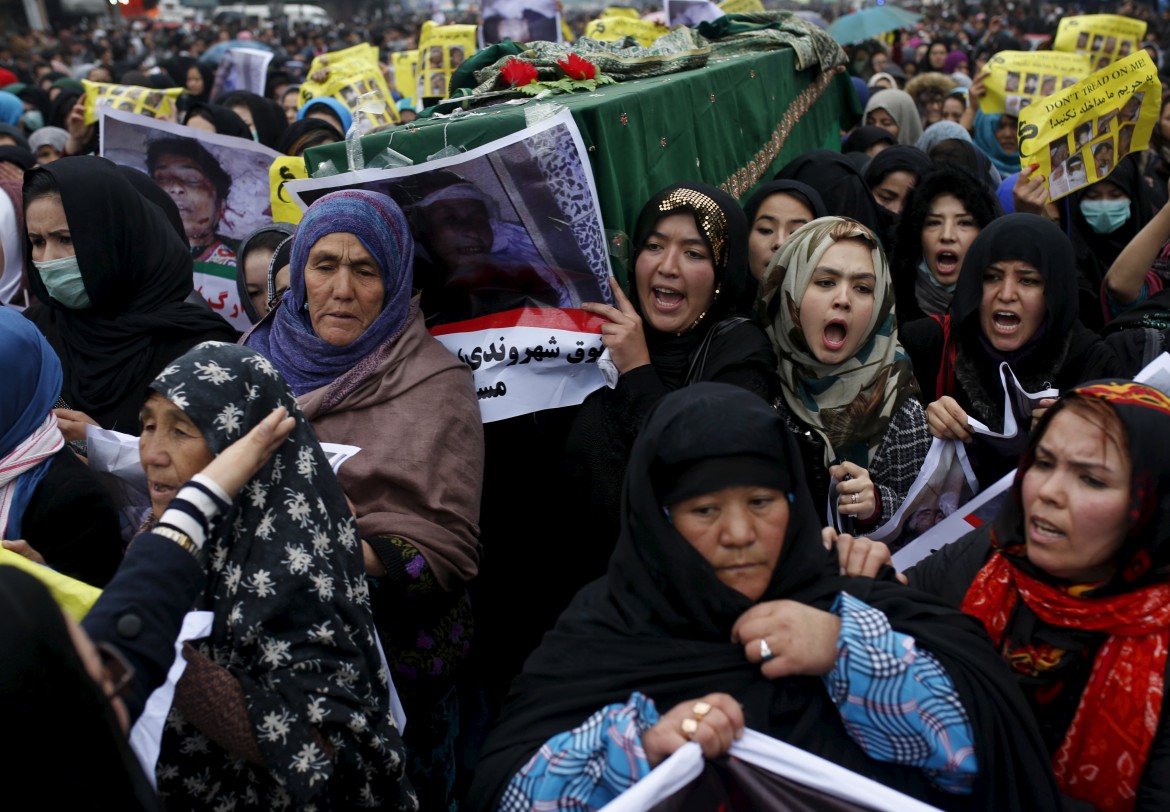News analysis.
In Kabul, women and minorities take to the streets
After a brutal massacre in Afghanistan, thousands of demonstrators are calling on the Ghani government to protect them. Will it meet their demands?

Something new and surprising happened in Afghanistan yesterday. A crowd of tens of thousands of people demonstrated in Kabul, hoisting the bodies of seven people killed, some decapitated, between Nov. 6 and 8 in Zabul Province, a month after they were taken hostage while traveling the road between Ghazni and Zabul.
It’s not clear who the culprits are: Some say it was an Islamic State cell in Afghanistan, others say it was the Taliban. In either case, there are seven bodies, all of them Hazaras, a historically persecuted Shia minority.
The protest was so large it seems to have taken everyone by surprise, including the security forces, who fired (in the air, if you believe the government spokesman) toward people trying to enter the grounds of the presidential palace. Ten were injured. But to reduce the story to “10 wounded in clashes” would be unfair. The event, which started in the Kote Sangi neighborhood of Kabul and moved to the city center, was mostly peaceful.
Historic in its breadth, the march gathered Afghans of all shapes, including many women, even if the core group comprised mainly Hazaras. As the Islamic State (or groups that invoke its name) tries to expand its influence in the country, citizens are afraid sectarianism will return with a vengeance — putting Hazaras again at particular risk.
The barbaric killings in Zabul are not the first, but they made the biggest headlines. And it kicked off protests in other cities, too: from Ghazni in Mazari Sharif in the north, where there were vigils and prayers, to Zabul and finally in Kabul.
Whatever anger had been building among Hazaras and other Afghan communities condensed yesterday in the capital toward the coalition government of President Ashraf Ghani and the quasi-prime minister, Abdullah Abdullah. In power since September 2014, they’re accused of not being able to protect their people and caring more about political infighting than the welfare of the state.
“Inaction is itself a crime,” reads one of the banners posted on the outer wall of the presidential palace. Ghani is aware the situation could become explosive and further undermine the already fragile position of his government. He tried to calm tempers with a television appeal promising “revenge and justice” for the seven victims.
He also welcomed a delegation representing the protesters, including relatives of the victims, into the palace. Their meeting, which included Ghani, Abdullah and the ministers of defense and the interior, was broadcast on life TV. It was a victory for the protest movement, but their demands were ambitious: They sought the establishment of a special section of the army whose sole task would be to protect the Hazara community. It would set a risky precedent in a country with an ongoing legacy of internecine conflict.
The tug of war is on between the government and the people, and it will continue beyond the issue, though important, of Hazara discrimination. The stakes involve the whole country and all Afghans. If the government cannot quickly guarantee security, demonstrations will continue. There was even talk on social media yesterday of a new Tahrir Square.
It’s a casual comparison, and not parallel. But it’s a safe bet the matter won’t end here. If the government accuses the demonstrators of trying to score political points, rather than responding to their legitimate demands, it would only throw fuel on the fire.
Originally published at http://ilmanifesto.info/a-kabul-le-donne-scendono-in-piazza/ on 2015-11-12
